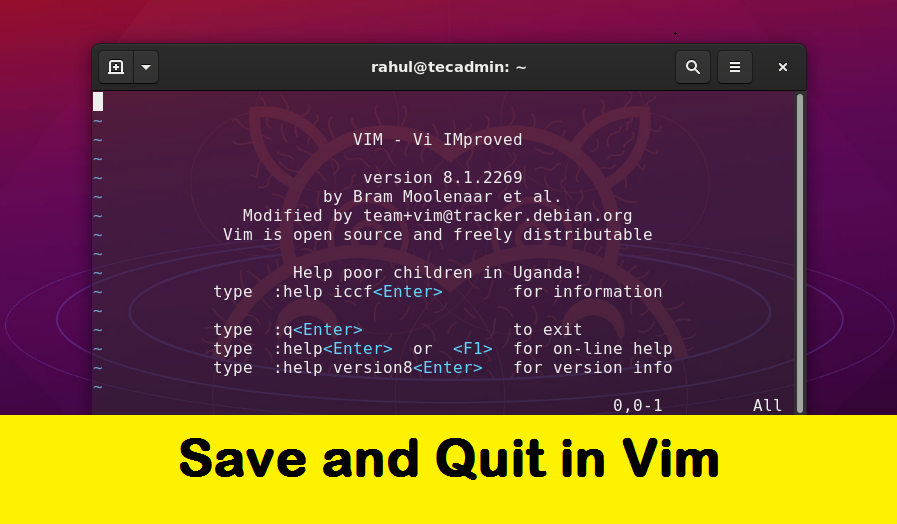
VIM SAVE QUIT HOW TO
You should know that how to exit or quit from the vi or vim text editor with or without saving changes in your Linux system. version Print version information and exit Conclusion

h or -help Print Help (this message) and exit Now follow the below steps to save the file: If you are in. clean 'nocompatible', Vim defaults, no plugins, no viminfo You can save a file in Vim or Vi by pressing :w followed by Enter key without quitting the file. startuptime Write startup timing messages to S Source file after loading the first file cmd Execute before loading any vimrc file
VIM SAVE QUIT WINDOWS
o Open N windows (default: one for each file) p Open N tab pages (default: one for each file) ttyfail Exit if input or output is not a terminal not-a-term Skip warning for input/output not being a terminal r (with file name) Recover crashed session N Not fully Vi compatible: 'nocompatible' m Modifications (writing files) not allowed Or: vim -t tag edit file where tag is defined To use this command, enter :q in command mode, then press Enter. This command exits Vim without saving changes to the current file. You can also use :wq when the file is marked as read-only (though not always vi/Vim. If you’ve made changes to a file and want to quit Vim without saving them, you can use the :q command. It works when theres a single file being edited (no splits) and its not modified.:q or :quit to quit without saving the current file.:wq to write (save) the current file and quit. If you want to get more help about vi or vim command, and you can run the following commands: You can use one of the following commands to quit Vim::q or :quit to quit. the vim text eidtor will quit and all changes will not be saved. If you want to exit the vim text editor without saving changes, and you need to press “ ESC” key firstly, and then press “ :q!” command, then press Enter key. Here’s how you can save files and quit the Vim editor: First, press the ESC key on the keyboard to enter the normal mode in the Vim editor.

Exit Without Saving Changes using vi or vim How to Save and Exit Vim Editor in Linux If you want to save your work before exiting the Vim editor, then the wq command will be handy for you. And the “ q” indicates that the vim editor should quit. Note: the “ w” indicates that the file should be written and saved which will overwrite existing file. If you want to save the current file and exit it from the vi or vim text editor, and you need to press “ ESC” key firstly, and type “ :wq” command. Then you need to press “ i” key in your keyboard to enter into the insert mode so that you can edit your file or add new content into the file. If you want to create a new file named mytest.txt in your Linux system, and you need to type the following command from the command prompt: $ sudo vim mytest.txt Vim is perfect for all kinds of text editing, from composing email to editing configuration files. It is an improved version of the vi editor distributed with most UNIX systems.Vim is often called a “programmer’s editor,” and so useful for programming that many consider it an entire IDE. Unlike other editors, Vim has several modes of operation, which can be a little intimidating for new users.Vim is a highly configurable text editor built to enable efficient text editing. Vim is the text editor of choice for many users that spend a lot of time on the command line.

When compared to the general-purpose word processor program, Vim is tailored to a more specific profile of usage and users i.e. Vi Improved (Vim) is somewhat difficult to learn, but most users are happy and ready to go through the learning curve to be more efficient in their jobs.
VIM SAVE QUIT INSTALL
Kindly refer to these related guides: How to install and remove Microsoft Edge Browser on Linux, how to install and configure BigBlueButton on Ubuntu Linux 16.04 LTS Xenial Xerus, How to setup SELinux on a Linux server and a brief introduction to Linux, and how to create disk partition in Ubuntu Linux. It exclusively uses the keyboard and provides a very efficient interface for editing programs and scripts. It is a widely-used default text editor for Unix-based systems and is shipped with virtually all versions of Unix. Vim stands for Visual instrument Improved. Vim is a screen editor for Linux, Unix, and other Unix-like operating systems. This tutor is designed to take you through how to create, edit, save and exit a file in Vi/Vim editor. Vi/Vim is a very powerful editor that has many commands, too many to explain in a tutor such as this.


 0 kommentar(er)
0 kommentar(er)
